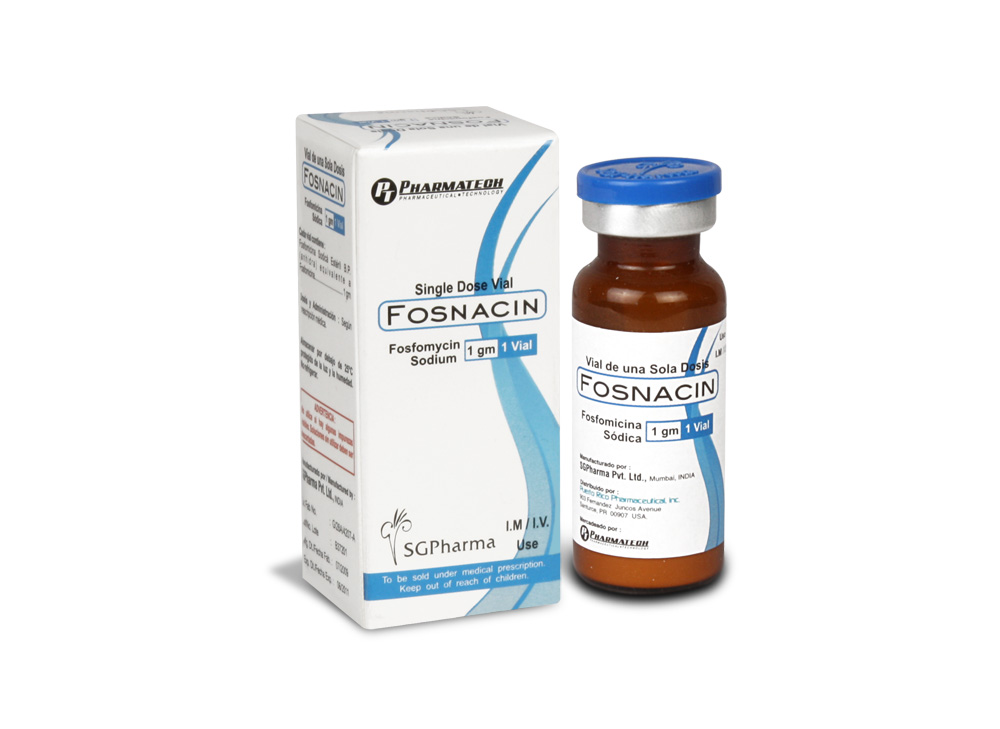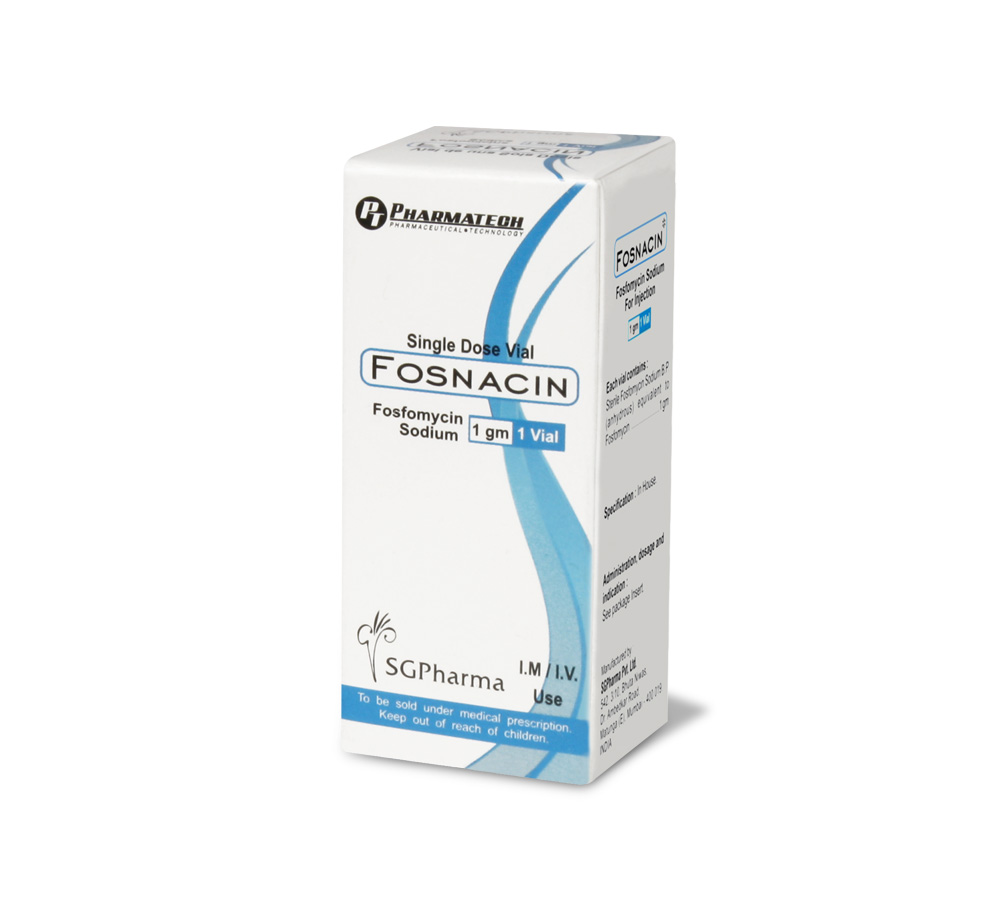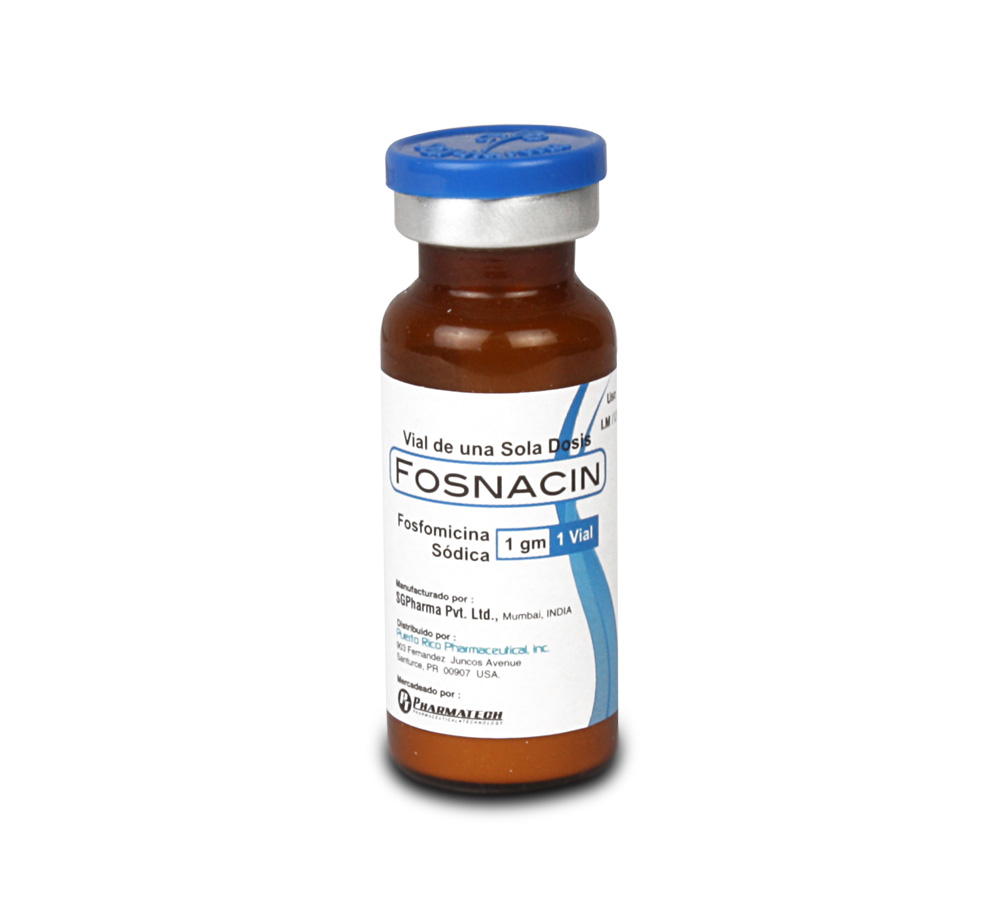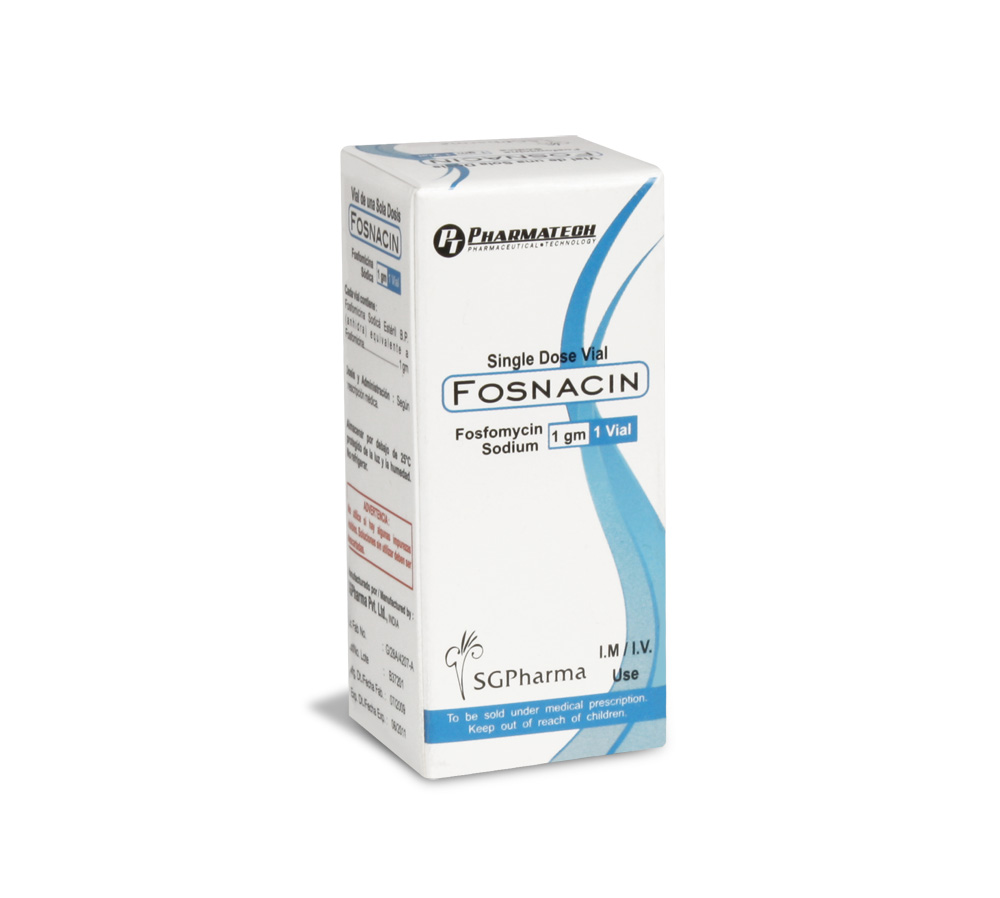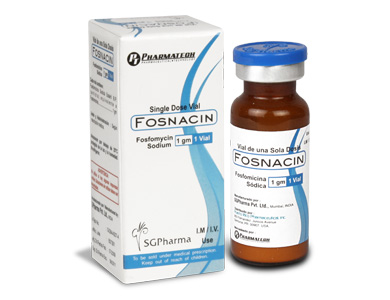
500 mg/1gm
For the use of a Registered Medical Practitioner or a Hospital or a Institution only.
FOSNACIN (Fosfomycin Sodium) is a synthetic broad-spectrum, bactericidal antibiotic. Chemically, Fosfomycin Sodium is Disodium (2R,2S)-3-methyloxiran-2-yl)phosphonate. The molecular formula is C3H5Na2O4P and molecular weight is 182.02.
STRUCTURAL FORMULA :
Its structural formula is :
-Structure.jpg)
FOSNACIN is white to almost white, very hygroscopic crystalline powder filled in vial of suitable size.
COMPOSITION :
Each vial contains :
Sterile Fosfomycin Sodium B.P. (anhydrous)
equivalent to Fosfomycin 500 mg
Each vial contains :
Sterile Fosfomycin Sodium B.P. (anhydrous)
equivalent to Fosfomycin 1 gm
ACTIONS :
Fosfomycin is a bactericidal antibacterial. Following active uptake into the cell it is reported to interfere with the first step in the synthesis of bacterial cell walls. It is active in vitro against a range of Gram-positive and Gram-negative bacteria including Staphylococcus aureus, some streptococci, most Enterobacteriaceae, Haemophilus influenzae, Neisseria spp., and some strains of Pseudomonas aeruginosa although some are resistant. Bacteroides spp. are not sensitive. Bacterial resistance to fosfomycin has been reported and
can be chromosomal or, in some organisms, transferred by plasmids encoding multiple resistance (for example in Serratia marcescens). However, there appears to be little cross-resistance with other antibacterials. Fosfomycin has been reported to demonstrate antimicrobial synergy with a wide range of antibacterials against organisms such as enterococci, meticillin-resistant Staphlococus aureus, and the enterobacteria. Such synergistic effects have been reported particularly with the beta lactams, but also with aminoglycosides, macrolides, tetracyclines, chloramphenicol, rifamycin, and lincomycin. Antimicrobial antagonism with a beta lactam has also been reported. There is some suggestion that use of fosfomycin with an aminoglycoside may also reduce the nephrotoxicity of the latter in vivo.
PHARMACOKINETICS :
Intravenous infusion of a 3 g dose results in peak serum concentrations of around 220 mcg/ml. The plasma half-life is about 2 hours. Fosfomycin does not appear to be bound to plasma proteins. It crosses the placenta and is widely distributed in body fluids including the CSF; small amounts have been found in breast milk and bile. The majority of a parenteral dose is excreted unchanged in the urine, by glomerular filtration, within 24 hours.
INDICATIONS :
Complicated and non complicated urinary infections : Cystitis, pyelitis, pyelonephritis, prostatitis, urethritis and gonoccocal urethritis
Respiratory infections : Tonsillitis, pharingitis, sinus infection, otitis media, laryngitis, bronchitis and pneumonia.
Gyneco-obstetric infections : Bacteriuria during pregnancy, adnexitis, miscarriage and septic childbirth, mastitis, and mammary abscesses.
Infections of the skin and adjacent tissues : Furunculosis, cellulites, pyoderma and infected wounds.
Gastrointestinal infections : Bacillary dysentery, gastroenteritis, typhoid and paratyphoid fever.
Other infections : Septicaemia, bacterial endocarditis, meningitis and brain abscesses, osteomyelitis, septic arthritis, surgical infections or infections caused by germs that are sensitive to the antibiotic in the formula.
Administration :
For intramuscular and intravenous use.
Dosage :
Intramuscular route :
Children over 40 kg of weight and adults : 1 or 2 g every 6 to 8 hours (50 to 100 mg/kg/day every 6 to 8 hours).
Children 20 to 40 kg of weight : ½ to 1 g every 6 to 8 hours (100 to 150 mg/kg/day every 6 to 8 hours).
Premature infants and children less than 20 kg of weight : 125 to 250 mg every 6 to 8 hours (100 to 200 mg/kg/day every 6 to 8 hours).
Intravenous route :
Children over 40 kg of weight and adults : 1 to 4 g every 6-8 hours (100 to 200 mg/kg/day every 6 to 8 hours or as intravenous drip).
Children 20 to 40 kg of weight : 500 mg to 2 g every 6 to 8 hours (100 to 300 mg/kg/day every 6 to 8 hours or as intravenous drip).
Premature infants and children less than 20 kg of weight : 125 to 500 mg every 6 to 8 hours (100 to 400 mg/kg/day every 6 to 8 hours or as intravenous drip).
Fosfomycin may also be used with beta-lactamic antibacterials.
CONTRAINDICATIONS :
FOSNACIN is contraindicated in patients with known hypersensitivity to the drug.
WARNINGS :
Clostridium difficile associated diarrhoea (CDAD) has been reported with use of nearly all antibacterial agents, including FOSNACIN, and may range in severity from mild diarrhoea to fatal colitis. Treatment with antibacterial agents alters the normal flora of the colon leading to overgrowth of
C. difficile.
C. difficile produces toxins A and B which contribute to the development of CDAD. Hypertoxin producing strains of
C. difficile cause increased morbidity and mortality, as these infections can be refractory to antimicrobial therapy and may require colectomy. CDAD must be considered in all patients who present with diarrhoea following antibiotic use. Careful medical history is necessary since CDAD has been reported to occur over two months after the administration of antibacterial agents.
If CDAD is suspected or confirmed, ongoing antibiotic use not directed against C. difficile may need to be discontinued. Appropriate fluid and electrolyte management, protein supplementation, antibiotic treatment of C. difficile, and surgical evaluation should be instituted as clinically indicated.
PRECAUTIONS :
Carcinogenicity :
Long-term carcinogenicity studies in animals have not been done.
Mutagenicity : FOSNACIN was not found to be mutagenic or genotoxic in vitro in the Ames test, in cultured human lymphocytes, or in Chinese hamster V79 cells, or in vivo in the mouse micronucleus assay.
Pregnancy : Category B
When administered intramuscularly as the sodium salt at a dose of 1 gm to pregnant women, fosfomycin crosses the placental barrier. FOSNACIN crosses the placental barrier of rats; it does not produce teratogenic effects in pregnant rats at dosages as high as 1000 mg/kg/day (approximately 9 and 1.4 times the human dose based on body weight and mg/m2, respectively). When administered to pregnant female rabbits at dosages as high as 1000 mg/kg/day (approximately 9 and 2.7 times the human dose based on body weight and mg/m2, respectively), foetotoxicities were observed. However, these toxicities were seen at maternally toxic doses and were considered to be due to the sensitivity of the rabbit to changes in the intestinal microflora resulting from the antibiotic administration. There are, however, no adequate and well-controlled studies in pregnant women. Because animal reproduction studies are not always predictive of human response, this drug should be used during pregnancy only if clearly needed.
Nursing Mothers :
It is not known whether fosfomycin tromethamine is excreted in human milk. Because many drugs are excreted in human milk and because of the potential for serious adverse reactions in nursing infants from FOSNACIN, a decision should be made whether to discontinue nursing or to not administer the drug, taking into account the importance of the drug to the mother.
Paediatric Use :
Safety and effectiveness in children age 12 years and under have not been established in adequate and wellcontrolled studies.
Geriatrics :
The bacteriologic effectiveness and safety profiles for women older than 65 years of age did not show clinically significant differences, as compared with those for women 65 years of age and younger.
INTERACTIONS AND INCOMPATIBILITIES :
Metoclopramide : When coadministered with FOSNACIN, metoclopramide, a drug which increases gastrointestinal motility, lowers the serum concentration and urinary excretion of fosfomycin. Other drugs that increase gastrointestinal motility may produce similar effects.
Cimetidine : Cimetidine does not affect the pharmacokinetics of fosfomycin when coadministered with FOSNACIN.
Laboratory value alterations : The following have been selected on the basis of their potential clinical significance (possible effect in parentheses where appropriate) not necessarily inclusive (>> = major clinical significance)
OVERDOSAGE :
Symptoms of a fosfomycin overdose may include vestibular loss, impaired hearing.
TREATMENT OF OVERDOSAGE :
In event of overdosage treatment must be symptomatic and supportive.
PHARMACEUTICAL PRECAUTIONS :
Parenteral drug products should be inspected visually for particulate matter and discoloration prior to administration, whenever solution and container permit.
STORAGE :
Store below 250C (770F), protected from moisture and light.
Do not refrigerate.
Use the solution immediately after reconstitution.
Discard any unused solution.
SHELF LIFE :
24 months from the date of manufacture.
PRESENTATION :
FOSNACIN 500 mg is supplied as 500 mg of Sterile Fosfomycin Sodium in 7.5 ml amber tubular glass vial. FOSNACIN 1 gm is supplied as 1 gm of Sterile Fosfomycin Sodium in 15 ml amber tubular glass vial.
Single vial pack.
Disclaimer : For the use of a Registered Medical Practitioner or a Hospital or a Institution only. Also it is not intended to be used by healthcare professionals or patients for the purpose of prescribing or administering these products. Questions regarding the complete and current content of product labeling / specification / presentation should be directed to SGPharma.

 Cardiovascular
Cardiovascular



